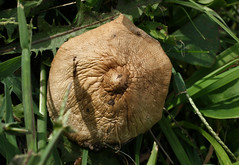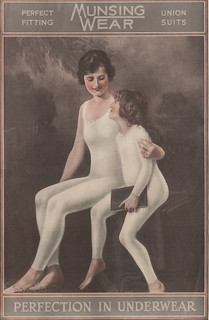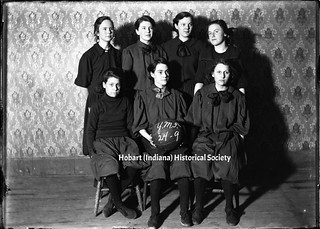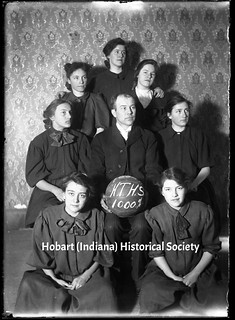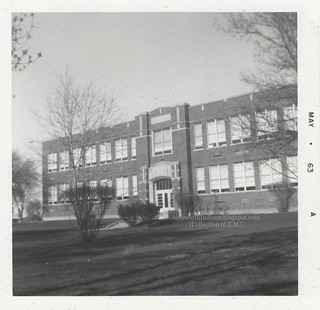Hobart's militia company had previously made itself useful in digging out from a
blizzard and in representing Hobart well at a
battalion drill. Now Company K was called on to do less cheerful work.
It began late in the morning on July 29, 1918, on the west side of the town of East Gary (now Lake Station). A woman hurrying along the street collapsed in a dead faint, and passers-by who came to her aid were alarmed by her condition, for she was heavily pregnant, and when brought back to her senses, she told a frightening story. Her name was Virginia Davenport,* she lived nearby with her husband and two children, and she had just been brutally attacked in her own home.
The good Samaritans sent for the police, for Dr. Clara Faulkner (who specialized in obstetrics and gynecology) and for Virginia's husband, William, who worked at a foundry only a few blocks away.
Virginia said that she had gone out to her backyard garden to gather vegetables, then come back into her kitchen around 11:15, lit the stove and set about preparing lunch. When she heard quiet footsteps behind her, she merely thought one of the children — her 13-year-old daughter or eight-year-old son — had come in through the front door. Suddenly a man grabbed her from behind and dragged her out of the kitchen, choking her so she could not scream. She believed he meant to rape her. As soon as she got a chance to speak, she begged him not to hurt her, offering him all the money in the house if he would just go. It worked: he took $45 and ran away. Virginia hurried out toward the foundry to tell her husband, but on the way she collapsed from shock.
The matter was all the more incendiary as Virginia said her attacker was a black man. As the
News commented: "This is said to be the fourth attack of white women by negroes in and around Gary during the past month. One woman was murdered."
Word spread quickly. The whole workforce of the foundry heard the news, and numerous civilians, many of them armed, turned out to supplement the local police force. Sheriff
Lewis Barnes brought county law enforcement to help with the manhunt. But the suspect had gotten at least half an hour's head start.
Around 4:00 p.m., someone called in with a report that a black man had been seen hiding in an outbuilding on a farm near Liverpool, but a quick search turned up nothing. On the assumption that the man might now be hiding in the marshy areas around there, Sheriff Barnes called over to Hobart, asking for Company K's help. Some 70 militiamen responded.
They set up patrols of all the roads in the Liverpool area. They searched in the tall grass of the marsh and in the woods. They kept at it all through the night, on through the next morning and into the afternoon. As the hours wore on, some local residents came out with coffee and sandwiches to keep the men going.
Although a few more reports came in that a possible suspect had been sighted, ultimately the search was fruitless. The tall grass of the marshy area made it, in the words of the
Gazette, like looking for a needle in a haystack; then there were the woods, and the city of Gary, with its ever larger and more anonymous crowds. Or perhaps the suspect had hopped a freight train and was long gone. Some 200 men had searched, for over 24 hours. Late the next afternoon, the search was called off. Finding the culprit would have to be a matter of detective work, or luck.
Newspapers lavished praise on the men of Company K for their service. "It gave them a little idea of the life of a scout and the hardships of militia service," said the
Gazette. The town board of East Gary passed a resolution thanking them.
The board and citizens of East Gary quickly got up a petition asking the Lake County commissioners to purchase trained bloodhounds. The petition invoked "the recent crimes committed within Lake county during the last five weeks, namely, the four rape cases and the last robbery and attempted rape case of East Gary, and … the large influx of negroes and undesirable people who are coming to the northern portions of the county on account of the call for labor in this section."
♦ ♦ ♦
I can't help but wonder whether the militia would have been called out had the suspect been white. As mentioned above, this incident followed a month-long wave of violent crime, so perhaps it's not a good example for speculation — it may have been a case of "enough is enough" even had all the suspects been white. On the other hand, look at the language I've just quoted from the East Gary petition for bloodhounds.
Though serious research on racism is beyond the scope of this blog, I've mentioned before and now I just want to mention again how clearly these old newspapers addressed an audience that was white and racist — but, I think, casually and nonchalantly racist. In other words, I get the impression that racism wasn't a rallying point or a conscious obsession, but an unthinking element of an outlook on life — at least at this time period, when the
percentage of non-white population was very small.
Racism always has the potential to inspire violence, but so far in my own reading I haven't seen that potential realized. I have yet to see a report of any violence in this little piece of Lake County that was clearly racially motivated. There was an incident around 1910 where some Hobart boys harassed a group of black street musicians, but a few years earlier some white musicians had suffered the same abuse.** In 1901 William Potter of Ainsworth, who was white, somehow tangled with a railroad employee named Richard Ross, who was black; each ended up suing the other and both cases were dismissed; but I can't conclude from the news report that this was not just another fight, like the fights we've seen between men of the same skin color. (But no, it could not have been
exactly the same, could it?)
However, details in the report of that incident are revealing: Ross's case against Potter was described as the "State of Indiana vs. Wm. Potter," while Potter's case was the "State of Indiana vs Richard Ross, colored." Such gratuitous emphasis upon the skin color of any non-white person was typical. White was assumed to be the standard, not needing mention; any variation from the standard was highlighted, usually appearing in the story's headline if it had one.
Serious reporting always used the then polite terms ("colored" or "negro") to describe African-Americans. (Note the reference, in the third column of the August 11, 1911 newspaper page
posted earlier, to the "colored picnic.") So far it's only humor that has tasted of venom; for example, in the some of the early years of the century the factory-produced pages of the
News often ran cartoons that grotesquely caricatured the appearance and dialect of black people. If anyone protested, I missed the report on it. (On the other hand, by 1918 those cartoons had disappeared.)
I'm just noting some examples and general impressions I've received from my reading thus far, but again, I can't say if or how any of this applies to what happened in July 1918.
________________________________
*The newspapers accounts never give the woman's first name, but I believe I have found the correct Davenports in the
1920 Census.
**Sorry I didn't make a note of the particulars when I encountered these two stories. Someday these newspapers will be digitized and searchable, and I wouldn't have to sacrifice several days' work to find cites for two incidents that don't prove anything anyway.
Sources:
♦ "East Gary Citizens Petition County to Buy Blood Hounds." Hobart News 8 Aug. 1918.
♦ "Hobart Militia Called Out in Effort to Get Negro Assaulter." Hobart News 1 Aug. 1918.
♦ "Local and Personal." Hobart News 8 Aug. 1918.
♦ "Local Drifts." Hobart Gazette 2 Aug. 1918.
♦ "Negro Attacks White Woman." Hobart Gazette 2 Aug. 1918.
♦ "Thank Co. K by Resolution." Hobart Gazette 9 Aug. 1918.
